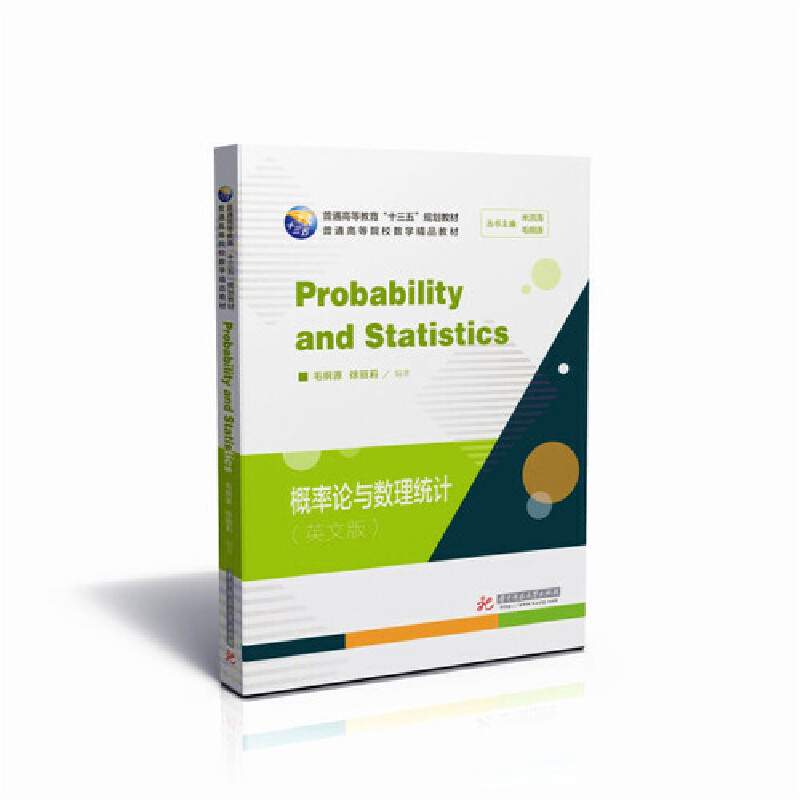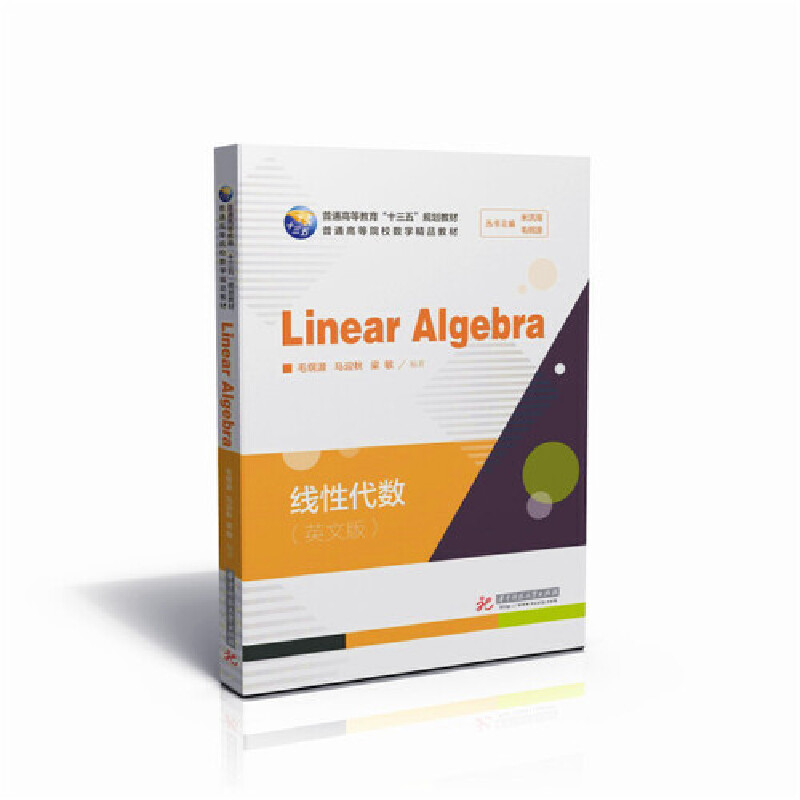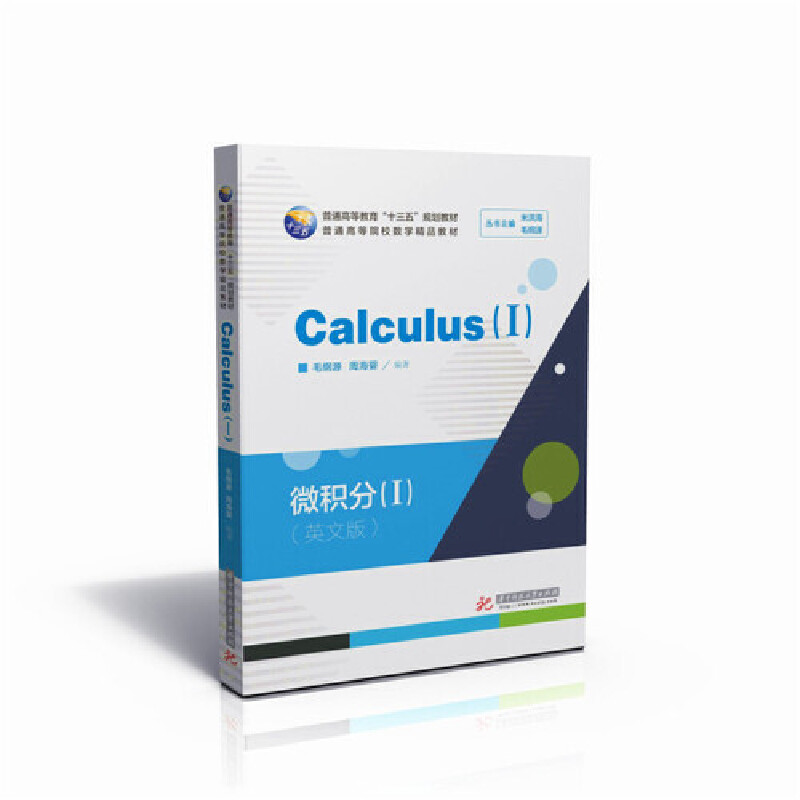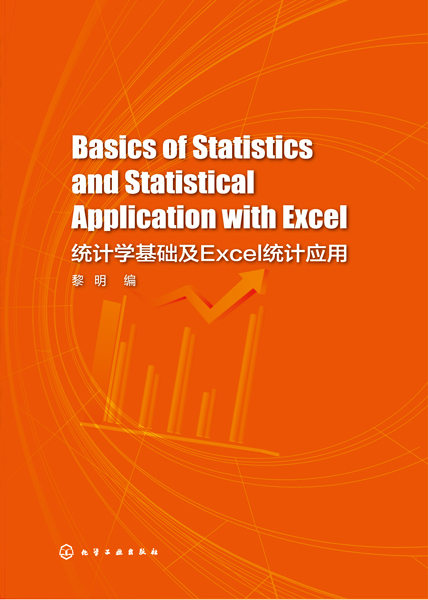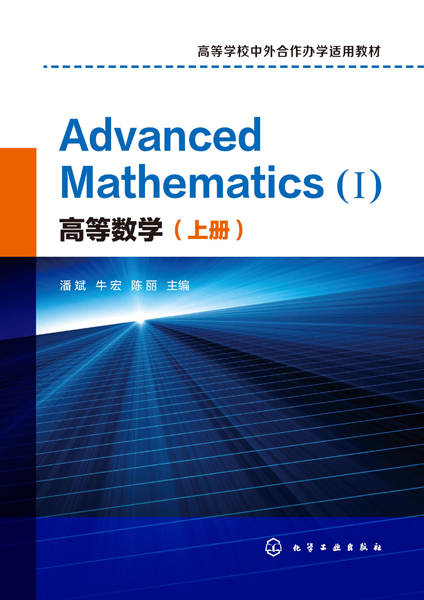概率论与数理统计(英文版)
定价:¥39.80
作者: 毛纲源,徐丽莉
出版时间:2017-12
最新印次日期:2017-12
出版社:华中科技大学出版社
- 华中科技大学出版社
- 9787568028295
- 1-1
- 205233
- 62261027-7
- 平装
- 16开
- 2017-12
- 264
- 理学
- 数学类
- O21
- 金融学、经济数学、金融管理等
- 本科
作者简介
内容简介
本书采用学生易于接受的知识结构方式和英语表述方式,科学、系统地介绍了概率论与数理统计中随机事件与概率、古典概率的计算、一维随机变量及概率分布、二维随机变量及其分布、随机变量的数字特征、大数定律和中心极限定理、样本及抽样分布、参数估计等知识。强调通用性和适用性,兼顾先进性。本书起点低,难度坡度适中,语言简洁明了,不仅适用于课堂教学使用,同时也适用于自学自习。全书有关键词索引,习题按小节配置,题量适中,题型全面,书后附有答案。
本书读者对象为高等院校理工、财经、医药、农林等专业大学生和教师,特别适合作为中外合作办学的国际教育班的学生以及准备出国留学深造学子的参考书。
本书读者对象为高等院校理工、财经、医药、农林等专业大学生和教师,特别适合作为中外合作办学的国际教育班的学生以及准备出国留学深造学子的参考书。
目录
Chapter 1 Introduction to Probability(1)
1.1 Sets and Set Operations(1)
1.2 Random Experiments(5)
1.3 Sample Space(6)
1.4 Events (Random Events)(8)
1.4.1 The concept of events (random events)(8)
1.4.2 Relations among events(10)
1.4.3 Operations of events(10)
1.5 Relative Frequency(14)
Exercise 1(15)
Chapter 2 Finite Sample Spaces(17)
2.1 Classical Probability Model(17)
2.1.1 Finite sample spaces(17)
2.1.2 Equally likely outcomes(19)
2.1.3 Classical probability model or equally likely probability model(20)
2.1.4 Counting methods(21)
2.2 Basic Properties of Probability(30)
Exercise 2(35)
Chapter 3 Conditional Probability and Independence(37)
3.1 Conditional Probability(37)
3.2 Product Rule (Multiplication Rule)(39)
3.3 Total Probability Law(41)
3.4 Bayes’Theorem(44)
3.5 Independent Events(46)
3.5.1 Independence of two events(46)
3.5.2 Independence of several events(49)
Exercise 3(51)
Chapter 4 Random Variables and Distributions(54)
4.1 Definition of Random Variable(54)
4.2 Discrete Random Variable(56)
4.2.1 Probability distribution of discrete random variables(56)
4.2.2 Some commonly used discrete probability distributions(59)
4.3 Cumulative Distribution Function(66)
4.3.1 Finding the cumulative distribution function of discrete variable(66)
4.3.2 Determining probability by the distribution function(68)
4.3.3 Finding the probability function of a random variable with cumulative distribution function(70)
4.4 Continuous Random Variable(70)
4.4.1 Continuous random variable and probability density function(70)
4.4.2 Some continuous probability distributions(73)
4.5 Finding the Distribution of Random Variable Function(81)
4.5.1 Finding the probability distribution of discrete random variable function(81)
4.5.2 Finding the p.d.f. of the function Y=g(X),where y=g(x) is continuous monotonic function(82)
4.5.3 Finding the p.d.f. of the function Y=g(X) where X is a continuous random variable(86)
4.5.4 Finding the distribution of the function Y=g(X) where X is a continuous random variable(87)
Exercise 4(88)
Chapter 5 Two-dimensional Random Variable(91)
5.1 Concept of Joint Probability Distribution(91)
5.1.1 Joint probability distribution for two discrete random variables(91)
5.1.2 Marginal distribution of discrete random variable(93)
5.1.3 Joint probability distribution function for two continuous random variables(98)
5.1.4 Marginal probability density function and conditional probability density(100)
5.1.5 The joint p.d.f. for two random variables(101)
5.2 Conditional Distribution(104)
5.3 Two Commonly Useful Distributions(108)
5.3.1 Two-dimensional uniform distribution(108)
5.3.2 Bivariate normal distribution(109)
5.4 Independence of Two Random Variables(110)
Exercise 5(115)
Chapter 6 Numerical Characteristics of Random Variables(118)
6.1 Expectation of Random Variable(118)
6.1.1 Expectation of discrete distribution(118)
6.1.2 Expectation of continuous random variable(119)
6.1.3 The expectation of function(120)
6.1.4 Properties of expectation(123)
6.2Variance of Random Variable(124)
6.2.1 Definition of the variance and the standard deviation(124)
6.2.2 Properties of the variance of random variable(127)
6.2.3 The expectation and variance of special probability distribution(129)
6.3 Covariance and Correlation(132)
6.3.1 Covariance(132)
6.3.2 Correlation coefficient(134)
6.4 Moments and Covariance Matrix(137)
Exercise 6(138)
Chapter 7 Law of Large Number and Central Limit Theorem(140)
7.1 Chebyshev’s Inequality(140)
7.2 Law of Large Number(142)
7.3 Central Limit Theorem(144)
Exercise 7(147)
Chapter 8 Basic Concept in Mathematical Statistics Introduction(148)
8.1 Random Sampling(148)
8.1.1 Population and sample(148)
8.1.2 Random sample(149)
8.1.3 Distribution of random sample(150)
8.2 Statistics(154)
8.3 Sampling Distribution(157)
8.3.1 The chi-square distribution(157)
8.3.2 The t-distribution(160)
8.3.3 The F-distribution(162)
8.4 Sampling Distribution Related to Sample Mean or (and) Sample Variance from Normal Population(165)
8.4.1 Sampling distribution related to sample mean or (and) sample variance from one normal population(165)
8.4.2 Sampling distribution related to sample mean of (and) sample variance from two normal populations(166)
Exercise 8(168)
Chapter 9 Parameter Estimation(171)
9.1 Point Estimation(171)
9.2 The Particular Properties of Estimators(172)
9.2.1 Unbiasedness(172)
9.2.2 Validity(173)
9.2.3 Consistency(175)
9.3 Moment Estimation and Maximum Likelihood Estimation(176)
9.3.1 Moment estimation(176)
9.3.2 Maximum likelihood estimation(177)
9.4 Interval Estimation of Mean and Variance for Normal Population(182)
9.4.1 The case for a single normal population(182)
9.4.2 The case for two populations N(μ1,σ21),N(μ2,σ22)(188)
Exercise 9(191)
Chapter 10 Hypothesis Testing(195)
10.1 General Concepts Used in Hypothesis Testing(195)
10.1.1 Statistical hypothesis(195)
10.1.2 Two types of errors(197)
10.1.3 Testing a statistical hypothesis(198)
10.2 Hypothesis Test for a Single Normal Population Parameter(201)
10.2.1 Hypothesis test for mean μ of a single normal population(201)
10.2.2 Hypothesis test for variance(205)
10.3 Hypothesis Test of Two Normal Population Parameters(208)
10.3.1 Hypothesis test for a difference between two normal populations(208)
10.3.2 Hypothesis test for two normal population variances(212)
10.4 The Relationship between Hypothesis Testing and Confidence Interval(215)
Exercise 10(216)
Answers to Exercises(219)
Appendix A Some Important Distributions(230)
Appendix B Statistical Tables(231)
Table B-1 Poisson Distribution(231)
Table B-2 Standard Normal Distribution(233)
Table B-3 t-Distribution(235)
Table B-4 χ2-Distribution(237)
Table B-5 F-Distribution(240)
1.1 Sets and Set Operations(1)
1.2 Random Experiments(5)
1.3 Sample Space(6)
1.4 Events (Random Events)(8)
1.4.1 The concept of events (random events)(8)
1.4.2 Relations among events(10)
1.4.3 Operations of events(10)
1.5 Relative Frequency(14)
Exercise 1(15)
Chapter 2 Finite Sample Spaces(17)
2.1 Classical Probability Model(17)
2.1.1 Finite sample spaces(17)
2.1.2 Equally likely outcomes(19)
2.1.3 Classical probability model or equally likely probability model(20)
2.1.4 Counting methods(21)
2.2 Basic Properties of Probability(30)
Exercise 2(35)
Chapter 3 Conditional Probability and Independence(37)
3.1 Conditional Probability(37)
3.2 Product Rule (Multiplication Rule)(39)
3.3 Total Probability Law(41)
3.4 Bayes’Theorem(44)
3.5 Independent Events(46)
3.5.1 Independence of two events(46)
3.5.2 Independence of several events(49)
Exercise 3(51)
Chapter 4 Random Variables and Distributions(54)
4.1 Definition of Random Variable(54)
4.2 Discrete Random Variable(56)
4.2.1 Probability distribution of discrete random variables(56)
4.2.2 Some commonly used discrete probability distributions(59)
4.3 Cumulative Distribution Function(66)
4.3.1 Finding the cumulative distribution function of discrete variable(66)
4.3.2 Determining probability by the distribution function(68)
4.3.3 Finding the probability function of a random variable with cumulative distribution function(70)
4.4 Continuous Random Variable(70)
4.4.1 Continuous random variable and probability density function(70)
4.4.2 Some continuous probability distributions(73)
4.5 Finding the Distribution of Random Variable Function(81)
4.5.1 Finding the probability distribution of discrete random variable function(81)
4.5.2 Finding the p.d.f. of the function Y=g(X),where y=g(x) is continuous monotonic function(82)
4.5.3 Finding the p.d.f. of the function Y=g(X) where X is a continuous random variable(86)
4.5.4 Finding the distribution of the function Y=g(X) where X is a continuous random variable(87)
Exercise 4(88)
Chapter 5 Two-dimensional Random Variable(91)
5.1 Concept of Joint Probability Distribution(91)
5.1.1 Joint probability distribution for two discrete random variables(91)
5.1.2 Marginal distribution of discrete random variable(93)
5.1.3 Joint probability distribution function for two continuous random variables(98)
5.1.4 Marginal probability density function and conditional probability density(100)
5.1.5 The joint p.d.f. for two random variables(101)
5.2 Conditional Distribution(104)
5.3 Two Commonly Useful Distributions(108)
5.3.1 Two-dimensional uniform distribution(108)
5.3.2 Bivariate normal distribution(109)
5.4 Independence of Two Random Variables(110)
Exercise 5(115)
Chapter 6 Numerical Characteristics of Random Variables(118)
6.1 Expectation of Random Variable(118)
6.1.1 Expectation of discrete distribution(118)
6.1.2 Expectation of continuous random variable(119)
6.1.3 The expectation of function(120)
6.1.4 Properties of expectation(123)
6.2Variance of Random Variable(124)
6.2.1 Definition of the variance and the standard deviation(124)
6.2.2 Properties of the variance of random variable(127)
6.2.3 The expectation and variance of special probability distribution(129)
6.3 Covariance and Correlation(132)
6.3.1 Covariance(132)
6.3.2 Correlation coefficient(134)
6.4 Moments and Covariance Matrix(137)
Exercise 6(138)
Chapter 7 Law of Large Number and Central Limit Theorem(140)
7.1 Chebyshev’s Inequality(140)
7.2 Law of Large Number(142)
7.3 Central Limit Theorem(144)
Exercise 7(147)
Chapter 8 Basic Concept in Mathematical Statistics Introduction(148)
8.1 Random Sampling(148)
8.1.1 Population and sample(148)
8.1.2 Random sample(149)
8.1.3 Distribution of random sample(150)
8.2 Statistics(154)
8.3 Sampling Distribution(157)
8.3.1 The chi-square distribution(157)
8.3.2 The t-distribution(160)
8.3.3 The F-distribution(162)
8.4 Sampling Distribution Related to Sample Mean or (and) Sample Variance from Normal Population(165)
8.4.1 Sampling distribution related to sample mean or (and) sample variance from one normal population(165)
8.4.2 Sampling distribution related to sample mean of (and) sample variance from two normal populations(166)
Exercise 8(168)
Chapter 9 Parameter Estimation(171)
9.1 Point Estimation(171)
9.2 The Particular Properties of Estimators(172)
9.2.1 Unbiasedness(172)
9.2.2 Validity(173)
9.2.3 Consistency(175)
9.3 Moment Estimation and Maximum Likelihood Estimation(176)
9.3.1 Moment estimation(176)
9.3.2 Maximum likelihood estimation(177)
9.4 Interval Estimation of Mean and Variance for Normal Population(182)
9.4.1 The case for a single normal population(182)
9.4.2 The case for two populations N(μ1,σ21),N(μ2,σ22)(188)
Exercise 9(191)
Chapter 10 Hypothesis Testing(195)
10.1 General Concepts Used in Hypothesis Testing(195)
10.1.1 Statistical hypothesis(195)
10.1.2 Two types of errors(197)
10.1.3 Testing a statistical hypothesis(198)
10.2 Hypothesis Test for a Single Normal Population Parameter(201)
10.2.1 Hypothesis test for mean μ of a single normal population(201)
10.2.2 Hypothesis test for variance(205)
10.3 Hypothesis Test of Two Normal Population Parameters(208)
10.3.1 Hypothesis test for a difference between two normal populations(208)
10.3.2 Hypothesis test for two normal population variances(212)
10.4 The Relationship between Hypothesis Testing and Confidence Interval(215)
Exercise 10(216)
Answers to Exercises(219)
Appendix A Some Important Distributions(230)
Appendix B Statistical Tables(231)
Table B-1 Poisson Distribution(231)
Table B-2 Standard Normal Distribution(233)
Table B-3 t-Distribution(235)
Table B-4 χ2-Distribution(237)
Table B-5 F-Distribution(240)

